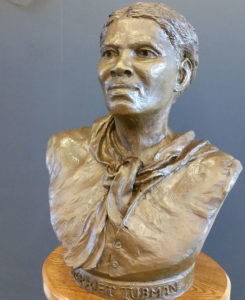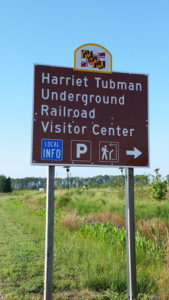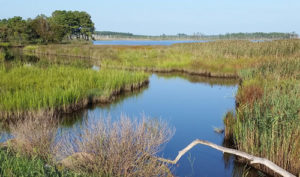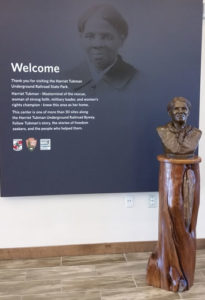Harriet Tubman Underground Railroad Visitor Center
 “I never ran my train off track and I never lost a passenger.” Harriet Tubman was fond of saying this in her later years, but during the 1850s when she was actively escorting enslaved people north to freedom using the Underground Railroad (UGRR) network, she was taking grave risks with her own life and liberty as well as that of the people she led. The Harriet Tubman Underground Railroad Visitor Center (HTVC) tells the story of this renowned “conductor” with her words and with exhibits providing insights into her early years and the historic events of her times. Sites and artifacts of the UGRR are limited. After all, its success depended on secrecy.
“I never ran my train off track and I never lost a passenger.” Harriet Tubman was fond of saying this in her later years, but during the 1850s when she was actively escorting enslaved people north to freedom using the Underground Railroad (UGRR) network, she was taking grave risks with her own life and liberty as well as that of the people she led. The Harriet Tubman Underground Railroad Visitor Center (HTVC) tells the story of this renowned “conductor” with her words and with exhibits providing insights into her early years and the historic events of her times. Sites and artifacts of the UGRR are limited. After all, its success depended on secrecy.

The history of slavery and of the UGRR is known. This HTVC puts a person, Harriet Tubman, at the center of the historic story. We know where she grew up and the work she did. After she escaped to free territory we know of a number of her trips back to her home region, and we know about many of the family members and friends she helped to escape. Some of the places and people that harbored her and the people with her are known. Most are not. But a drive through this rural landscape of “Chesapeake Bay country” can provide a sense of the woman and the times. Sensitivity to this landscape can help the visitor imagine and understand the events and the people who risked so much to gain so much.
The Site Is the Setting

The HTVC in Dorchester County is approximately a two-hour drive from Washington D.C. to the Eastern Shore of Maryland – that is, east of the Chesapeake Bay. The county seat of Dorchester County is Cambridge on the Choptank River. The Cambridge courthouse was the scene of slave auctions and almost the scene of auctions of some of Tubman’s family members.
The HTVC is not at Harriet Tubman’s birthplace, like many national park sites, nor at another notable place in her life. But the landscape around the HTVC and across the broader region is an integral part of her story. The HTVC property is carved from Blackwater National Wildlife Refuge (BNWR), so the setting is protected. The farm fields, woodlands, impoundments and open waters of the refuge provide cover and habitat for the migratory waterfowl and other creatures and give a sense of the mid-nineteenth century landscape.
The land of Tubman’s youth is the coastal plain of Delmarva, a region of farming, timbering, marshes, and rivers. Dorchester County is overwhelmingly low lying and flat. The waterways and the land peninsulas (“necks” in this region) intertwine like the fingers of clasped hands. Places that are nearby as the crow flies may be miles apart as the road winds. Woodland trees are not especially tall, but the woods are thick, and the ground cover can be dense. In marshy areas, “wetlands,” there may by little hillocks of dry land. The roads are now paved and the field crops may differ, but imagination may help the visitor form an impression of former times.
The Historic Setting
Students studying the period leading to the Civil War typically concentrate on the national political scene of presidential elections and federal legislation. The story of a single person leading small groups of individuals through the hazards of escape can give a different perspective to illuminate the political story.
The historic setting of the 1840s and 1850s is one of Northerners’ growing antislavery sentiment and of Southerners’ steadfast commitment to slaveholding in a primarily agrarian economy. Political parties shifted and realigned. Opinions became increasingly entrenched with successive administrations: John Tyler (following death of William Henry Harrison 1840, Whig); James K. Polk (elected 1844, Democrat); Zachary Taylor (elected 1848, Whig); Millard Fillmore (following Taylor’s death in 1850, Whig); Franklin Pierce (elected 1852, Democrat); James Buchanan (elected 1856, Democrat); and finally Abraham Lincoln, elected in 1860, Republican. Other important events: The Missouri Compromise, 1820, set the precedent that new states would be admitted to the Union in pairs, one free state and one slave state together. The Fugitive Slave Act, 1850, provided that escaped slaves found in the North must be returned. The Dred Scott decision in 1857 ruled that Dred Scott, a slave, was not a citizen and had not obtained his freedom because he had been taken from a slave state to a free state; it also essentially ruled the Missouri Compromise unconstitutional. The Lincoln-Douglas debates (1858) made Lincoln well known when he ran for the presidency. Then in April 1861 the South fired on the Union troops at Ft. Sumter in the harbor of Charleston, South Carolina touching off the Civil War.
The history is the big story. But it played out in the lives of individuals on local landscapes. One such individual whose local actions illustrated the larger context is Harriet Tubman in Dorchester County on Maryland’s Eastern Shore.
Harriet Tubman, the Person and Her Actions

Harriet Tubman was born, it is thought, in 1822 near the village of Madison. She was born Araminta Ross, and was called Minty. Her parents, Ben and Harriet (Rit) were slaves owned by different, though related, people. In 1844 Harriet married John Tubman, a free African American, and about that time took her mother’s first name, Harriet (Larson, p. xvi). Tubman’s father was freed in 1840 by act of his deceased owner’s will (Larson p. 27). Tubman’s brothers remained enslaved until she conducted them to Canada in late 1854. In 1855 Ben bought Rit, then 70 years old, for $20. In pre-Civil War Dorchester County, approximately one-half of the African Americans were free.
One incident in Tubman’s childhood had lifetime repercussions. When she was about seven years old, she accompanied a slave woman of her owner’s household to make a purchase at the Bucktown store. Also at the store were another slave and his overseer. As the two men argued and the slave turned to leave, the overseer threw a two-pound counter weight at him mistakenly hitting Tubman in the head. She dropped to the floor unconscious. It was several days before she recovered, and she carried the scar, a dent in her forehead, the rest of her life. Until her death Tubman was prone to suddenly falling asleep, awakening in a few moments, and she had visions and recurring dreams.
As a youngster, aged about six, Tubman was assigned to collect the catch in muskrat traps. Muskrat is a rodent that lives in marshland, about a foot long when fully grown. The hides are most valuable when the muskrat is caught in the winter when the fur is thick. That’s when the water is cold, sometimes frozen over. Checking muskrat traps is a cold, unpleasant assignment.
Harriet’s father, Ben, worked in timbering, cutting trees and hauling the lumber to wharfs to be sent to shipbuilders in Baltimore. In her teens, Tubman worked with him. Tubman was a strong, effective worker. It was not unusual for a slave owner to hire out a slave for wages which would be paid to the owner. When she was about 25 Harriet paid her owner a fee, estimated at $50 – $60, and then for the next year she kept her wages. With her income she bought two oxen which would have boosted her wage rate.
Tubman would have known a number of people in the broader community. In the lumber camps and river docks she would have met people from beyond the immediate region. Water transport was widespread with boats docking at the wharfs of large homes as well as at the town docks. African Americans working on the boats would have brought news of a wider world. Perhaps the most valuable aspect of her varied work and locations was learning to live on the land.
The horrors of slavery were real. “Every time I saw a white man I was afraid of being carried away. I had two sisters carried away in a chain gang ― one of them left two children. We were always uneasy” (HTVC). The sculptured bust of Tubman displayed in the HTVC includes the raised scars on the back of her neck ― marks of whipping.
Harriet Tubman was determined to be free. As she said looking back in 1886, “I had reasoned this out in my mind; there was one of two things I had a right to, liberty or death; if I could not have one, I would have the other, for no man should take me alive” (HTVC).
After an aborted attempt to escape with her brothers, she went alone. She left after dark one Saturday night in 1849 (Adler p.23). With no work done on Sunday, she would not be missed for two days. Looking back on that 1849 flight to freedom and thinking about her feelings as she crossed into a free state, she said, “When I found I had crossed that line, I looked at my hands to see if I was the same person. There was such a glory over everything the sun came like gold through the trees, and over the fields, and I felt like I was in heaven” (HTVC). What was unexpected in the following weeks, was how much she missed her family. She determined that they too should be free and that she would see to it. Yet every time she returned to Dorchester County to lead others north, she was traveling from a safe place to a place of danger – a place where detection and capture meant the probability of a whipping, or worse, and the possibility of being “sold south.”
In late 1850 through friends, John Bowley, a free African American, contacted Tubman for help. This took some coordination. He was a ship carpenter in Baltimore, but his enslaved family still lived on their owner’s farm on the Eastern Shore. Bowley’s wife, Kessiah, a niece of Tubman, together with the couple’s two young children, was to be sold in an auction on the courthouse steps in Cambridge. Tubman got to Baltimore and met with Bowley to plan his wife’s escape. At the auction, Bowley made the highest bid for the woman and the two children. The officials managing the auction broke for lunch and returned to collect payment but found that the high bidder was no longer around. As they started to re-auction Kessiah, they realized she too was gone. The four members of the Bowley family hid in a nearby cellar and slipped away at night in a small boat on the Choptank River and then sailed to Baltimore where they met Tubman who guided them north to Philadelphia and freedom (Adler p. 48). December weather added to the hazard of the 75-mile journey up the Chesapeake Bay to Baltimore.
In preparing for another journey, Tubman sent a coded letter message to a friend. When the suspicious postal inspectors could not find anything wrong, they handed the letter to the intended recipient who read it, understood the message and tossed the letter back saying it made no sense to him. He then went and alerted Tubman’s brothers to be ready to leave at a moment’s notice.
After gaining his freedom, Tubman’s father had established a home for himself and Rit in Poplar Neck in Caroline County, 40 miles from the Brodess Plantation, where Harriet’s brothers lived near Bucktown. On Christmas Eve, 1854, the brothers went to their parents’ home. Eight people waited in a corncrib, unwilling to let Rit Ross know her children were so close for fear her emotions would alert other people. Ben Ross brought food to them. Knowing he’d be questioned by slave catchers and wanting to answer truthfully that he “hadn’t seen them,” Ben covered his eyes with a handkerchief as he helped his grown children.
Tubman had an unshakable faith that God would protect her and would show her the way to safety in the years she led people north to freedom. One time she was escorting a number of escaping slaves. She had a premonition of danger and immediately left the road leading her “passengers” to wade through chest deep water to cross a river. The danger was real since slave catchers were waiting ahead on the road. Describing her safe escape, she said “It wasn’t me. It was the Lord” (Adler p. 59).
In all, Tubman made, it is believed, 13 trips between the Eastern Shore and free lands, escorting 70 enslaved persons to freedom, and her advice helped at least 50 others escape. No wonder she was called “Moses.” In later years she was fond of saying, “I never ran my train off track and I never lost a passenger” (Adler p.4).
After the Civil War broke out, Tubman went south and aided efforts of the Union Army. She went on one raid up the Combahee River in South Carolina to disrupt Confederate supply lines. As slaves in plantations along the river realized the boats were Union boats, they swam to get aboard. Tubman also helped in the field hospitals for the black troops and distributed food and clothes to escaping slaves who flocked to the Union camps. In later years, Tubman made her home in Auburn, New York, where her parents and some siblings had settled after the war and after returning to the United States from Canada. Tubman actively supported women’s suffrage. She died in 1913.
The Harriet Tubman Underground Railroad Visitor Center

The Harriet Tubman Underground Railroad Visitor Center tells the story of Harriet Tubman’s life in the context of her times. The design concept of the visitor center is “The View North,” referencing the direction the slaves took towards freedom setting their course by the North Star. The layout of the building and the exhibits within it follow a progression northward.
Although not particularly “high tech,” the exhibits, the artifacts of model cabins, the two-pound weight, the video of the region with a narrative commentary of her escape trips all contribute to an immersion in Tubman’s world. The context includes acknowledgment of the dangers risked by other people, both enslaved and free, in helping the passengers along on the “railroad.”
Born into slavery, Tubman was small and unable to read and write. She freed herself and others and continued to be a voice for individual rights all her life. The HTVC presents her story. The setting, the Dorchester County landscape, is an integral part of the story.
DOI: 10.14433/2017.0046
_________________________________
Bibliography:
Adler, David A. 2013. Harriet Tubman and the Underground Railroad. New York: Holiday House. This biography is often classified in the children’s or youth portion of a library.
HTVC, Harriet Tubman Underground Railroad Visitor Center exhibits.
Larson, Kate Clifford. 2004. Bound for the Promised Land. New York: Ballantine Books. This is a full-length biography of Harriet Tubman.
Lockhart, Barbara M. 2012. Elizabeth’s Field. North Charleston, South Carolina: c. Barbara M. Lockhart. This book of fiction is based on extensive research and the personal oral history with the author’s elderly African American neighbor who heard the stories first hand. The author’s land had been owned briefly in the 1850s by a freed African American woman. This unusual event gave rise to extensive research and this fictional account weaving the lives of slaves and free, owner and slave, and the life of the times. Today’s high school and college students find it to be the basis of discussion and enhanced appreciation for people and place. Copies of Elizabeth’s Field are available at the HTVC and through Amazon.
_________________________________
Sites of Visitor Interest
Harriet Tubman Underground Railroad Visitor Center
Harriet Tubman Underground Railroad Byway (Tubman Byway) — The Byway maps a route of over 130 miles in Maryland, Delaware and Pennsylvania showing over 30 sites linked with Tubman’s life and work.
Blackwater National Wildlife Refuge
Statue of Frederick Douglass, Easton, Maryland — On the grounds of the Talbot County Courthouse at 11 North Washington Street, in downtown Easton.
Adkins Arboretum, Ridgeley Maryland
Academy Art Museum, Easton, Maryland
Chesapeake Bay Maritime Museum, St. Michael’s, Maryland — The 18-acre campus on the Miles River is an active center with historic watercraft and interpretive displays of life in the region, watermen, farmers, tourists, people who have made their living from the Chesapeake Bay and the region.


